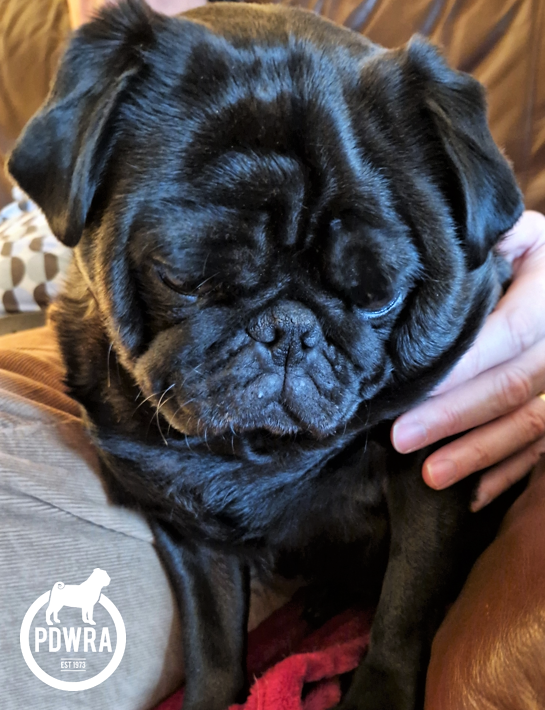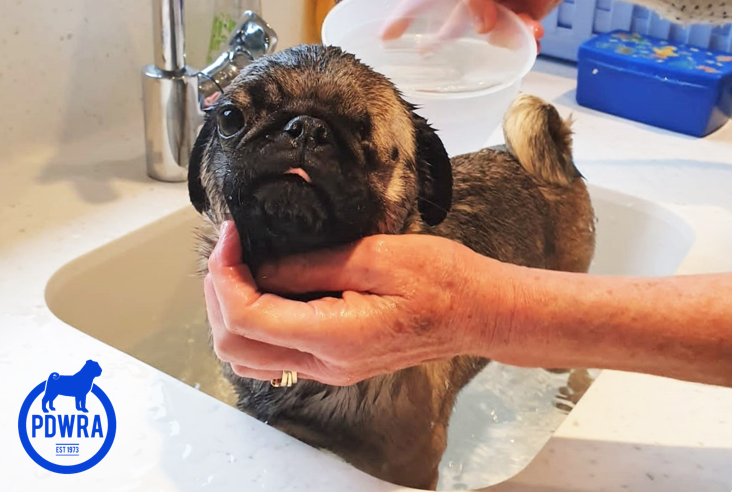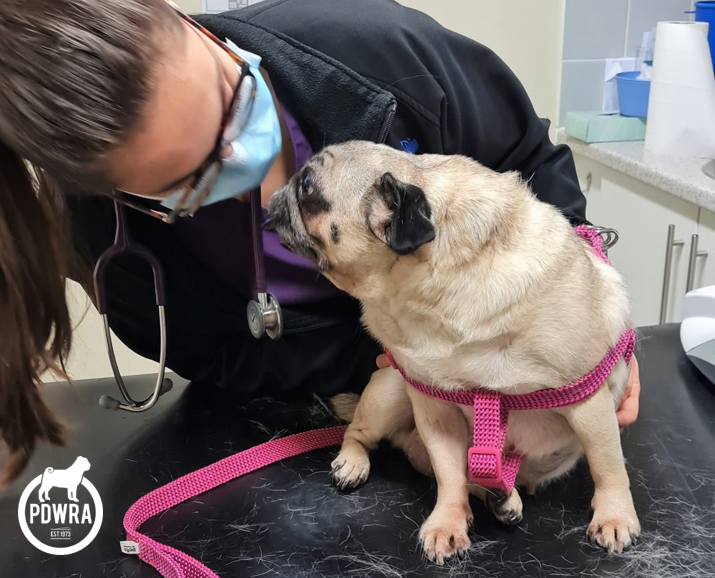Written by Helen McKee (MRCVS), PDWRA Vet Advisor:
Atopic Dermatitis (Itchy skin)
Atopy is a condition where the body has an allergic reaction to certain substances (like pollen and household dust), and in dogs, it’s expressed as itchiness of the skin (atopic dermatitis). The immune system reacts inappropriately when the dog comes into contact with allergens to which it is allergic and this leads to the skin becoming itchy. Once the dog starts to damage the skin by scratching and rubbing, secondary bacterial and yeast (Malassezia) infections commonly develop.

These dogs have a genetic predisposition to develop allergies and unfortunately, it is a condition we see all too commonly in pugs. It is generally caused by inhaling allergens, but less commonly, can also be due proteins in the diet (food allergy).
The main sign is the dog scratching excessively; they can also rub along on their bottom which can be mistaken for anal gland problems. The skin can be red, flaky or with little bumps on it.
Ears are likely to be irritated and inflamed. Because of a pug’s narrowed ear canals, and their enclosed (and moist) nature, it can often result in ear infections.
If left untreated, a dog can become more itchy (pruritic) and develop secondary signs, such as hair loss, thickening (lichenification) and/or blackened skin. Ear canals can be become inflamed, swollen and thickened causing further narrowing of the ear canal.
The first step is to ensure that the itchiness is not being caused by parasites, such as fleas or mites. Ongoing effective flea treatment is important; many of the flea treatment products on the market now also work against mites (such as Bravecto).
Depending on the severity of the condition, a vet may do a skin scraping to to look for mites and secondary infections such as fungo. Once parasites are ruled out, any excessive growth of bacteria and/or fungi need to be treated. Often this is by the use of a medicated shampoo such as Malaseb.

It is also important to treat any associated ear infections. Again, the vet make take a swab of the ear, and look under the microscope. If they see bacteria, especially rod shaped ones (which can be a nasty bacteria) they may go on to culture. Treatment can involve both local treatment (drops into ears), which can be as long as 6-8 weeks in serious cases, and tablets, depending on severity.
Once under control, it is vitally important that ears are part of the ongoing management of the atopy, as ear canals can become so thickened that they block the ear canal resulting in deafness. If this occurs, an expensive operation to remove the ear canal (TECA) may be needed to prevent infection spreading into the middle and inner ear (head tilt, dizziness) or in the most extreme cases, reaching the brain.
Once a diagnosis of atopic dermatitis is made, it can then be treated. The condition does not go away, but generally can be controlled with ongoing management.
If a dog is under 12 months of age, then it is more likely to be food related. If it develops after one year of age, then more often that not, it is due to breathing in allergens like pollen.
The easiest way to rule in (or out) an allergy to certain foods, is to exclusively feed hypoallergenic food for a minimum of 6 weeks. Although these specialised foods are expensive, in my opinion, it is worth the cost to find out if food is a factor in the dog’s atopic dermatitis. There are only three commercially available hypoallergenic diets (where the protein is hydrolysed in the food so the body doesn’t react to the protein), and these are produced by Purina, Royal Canin and Hill’s.

If the condition improves on the diet (without concurrent medication) it gives a positive diagnosis and the dog will need to remain on the diet.
Some vets may suggest blood tests to ascertain the proteins a dog is allergic to, but unless considering immunotherapy, dermatologists can often feel they are not needed and can incur unnecessary extra costs too.

There are a number of drugs that can be used to treat atopic dermatitis. Traditionally, steroids were used but they can have bad side effects.
More modern drugs (with less side effects) include Cytopoint, a monthly injection, and Apoquel, a tablet.
Regular medicated shampoo baths, along with the use of ear flushing products are often used alongside the medication, to control the atopy.
If the symptoms persist despite the use of Cytopoint or Apoquel, I would recommend being referred to an Advanced Practitioner or Specialist in Dermatology to ensure the diagnosis is correct and optimal treatment is given.
This is by no means an exhaustive article, merely a summary of atopic dermatitis which I hope will give a better understanding of the condition.
Helen McKee (MRCVS)
PDWRA Vet Advisor
For further pug health related articles please see: Pug Health & Wellbeing | The Pug Dog Welfare & Rescue Association (pugwelfare-rescue.org.uk)


